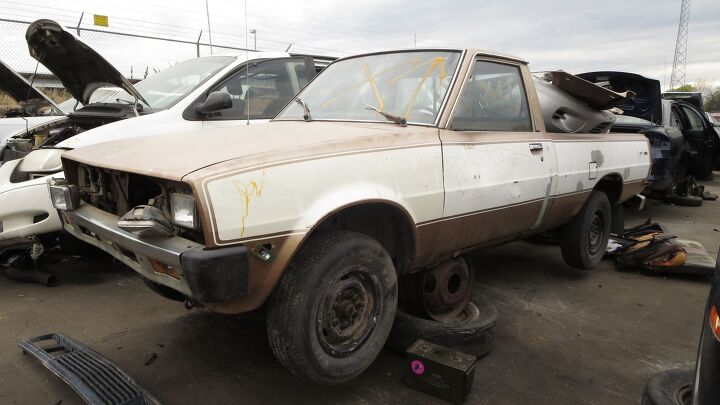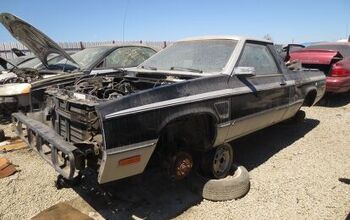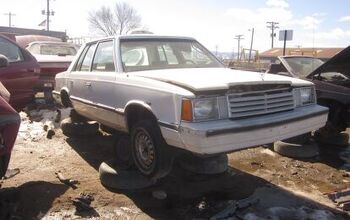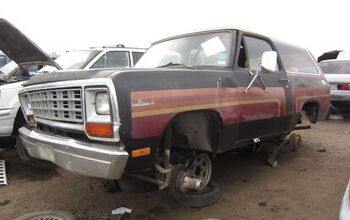Junkyard Find: 1983 Dodge Ram 50 Prospector

Small pickups sold pretty well in the United States during the Malaise Era, and Ford and GM cashed in by importing and rebadging Mazda and Isuzu trucks, respectively. Chrysler, late to the party, turned to longtime partner Mitsubishi and began bringing in first-generation Forte pickups, starting in the 1979 model year.
Here’s a Dodge-badged version I found last week in a Denver self-service yard.
The Dodge Ram 50 (aka Dodge D50) and Plymouth Arrow pickup were cheap, fairly reliable, and got the job done. Once Mitsubishi started selling vehicles in the United States under its own badging, small-truck shoppers could buy a Mighty Max version as well.
The 2.6-liter Astron four-cylinder engine powered a bewildering assortment of US-market vehicles, from the K-Cars with “Hemi 2.6” engines to the exquisitely 1980s Mitsubishi Starion.
This truck has plenty of body filler and general hooptieness, but doesn’t seem rusty.
A very simple little truck, with simple controls and not much to go wrong. And now its constituent materials will reenter the commodities food chain.
The best EPA fuel economy of all small pickups with optional automatic transmissions? Yes, the D50 and its optimistic 28 highway miles per gallon.
You don’t have to look tough to be tough.
By 1983, the Ram 50 had to compete with the identical Mighty Max.

Murilee Martin is the pen name of Phil Greden, a writer who has lived in Minnesota, California, Georgia and (now) Colorado. He has toiled at copywriting, technical writing, junkmail writing, fiction writing and now automotive writing. He has owned many terrible vehicles and some good ones. He spends a great deal of time in self-service junkyards. These days, he writes for publications including Autoweek, Autoblog, Hagerty, The Truth About Cars and Capital One.
More by Murilee Martin
Latest Car Reviews
Read moreLatest Product Reviews
Read moreRecent Comments
- Redapple2 Love the wheels
- Redapple2 Good luck to them. They used to make great cars. 510. 240Z, Sentra SE-R. Maxima. Frontier.
- Joe65688619 Under Ghosn they went through the same short-term bottom-line thinking that GM did in the 80s/90s, and they have not recovered say, to their heyday in the 50s and 60s in terms of market share and innovation. Poor design decisions (a CVT in their front-wheel drive "4-Door Sports Car", model overlap in a poorly performing segment (they never needed the Altima AND the Maxima...what they needed was one vehicle with different drivetrain, including hybrid, to compete with the Accord/Camry, and decontenting their vehicles: My 2012 QX56 (I know, not a Nissan, but the same holds for the Armada) had power rear windows in the cargo area that could vent, a glass hatch on the back door that could be opened separate from the whole liftgate (in such a tall vehicle, kinda essential if you have it in a garage and want to load the trunk without having to open the garage door to make room for the lift gate), a nice driver's side folding armrest, and a few other quality-of-life details absent from my 2018 QX80. In a competitive market this attention to detai is can be the differentiator that sell cars. Now they are caught in the middle of the market, competing more with Hyundai and Kia and selling discounted vehicles near the same price points, but losing money on them. They invested also invested a lot in niche platforms. The Leaf was one of the first full EVs, but never really evolved. They misjudged the market - luxury EVs are selling, small budget models not so much. Variable compression engines offering little in terms of real-world power or tech, let a lot of complexity that is leading to higher failure rates. Aside from the Z and GT-R (low volume models), not much forced induction (whether your a fan or not, look at what Honda did with the CR-V and Acura RDX - same chassis, slap a turbo on it, make it nicer inside, and now you can sell it as a semi-premium brand with higher markup). That said, I do believe they retain the technical and engineering capability to do far better. About time management realized they need to make smarter investments and understand their markets better.
- Kwik_Shift_Pro4X Off-road fluff on vehicles that should not be off road needs to die.
- Kwik_Shift_Pro4X Saw this posted on social media; “Just bought a 2023 Tundra with the 14" screen. Let my son borrow it for the afternoon, he connected his phone to listen to his iTunes.The next day my insurance company raised my rates and added my son to my policy. The email said that a private company showed that my son drove the vehicle. He already had his own vehicle that he was insuring.My insurance company demanded he give all his insurance info and some private info for proof. He declined for privacy reasons and my insurance cancelled my policy.These new vehicles with their tech are on condition that we give up our privacy to enter their world. It's not worth it people.”


















































Comments
Join the conversation
I still have an 87 D50 in my driveway. It ran until a few years ago. No power steering, no a/c, no radio, no cupholders, no tint at the top of the windshield, no power anything. Something happened with the stupid Mikuni carb. I took it off, and managed to break it. Yes. The bottom half was plastic. You can buy a Weber carb kit for it.
Great little truck and very tough. There is still a demand for small trucks but for some reasons they aren't being built anymore as far as I can tell.